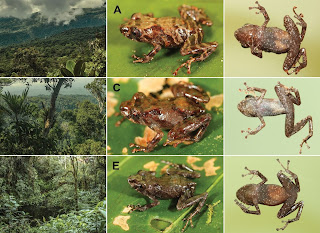 |
| Pristimantis sira Chávez, García-Ayachi & Catenazzi, 2021 |
Abstract
We describe a new species of frog from the eastern slopes of the Andes in central Peru. Pristimantis sira sp. nov. has a distinctive crossing mark on the iris and no tympanum. The new species is closely related to P. antisuyu Catenazzi & Lehr, 2018, P. cruciocularis Lehr, Lundberg, Aguilar & von May, 2006, and P. erythroinguinis Catenazzi & Lehr, 2018, but is easily differentiable by lacking colour blotches on groins. Pristimantis sira sp. nov. inhabits the mountain forests from 1550 to 2200 m a.s.l., inside a national reserve threatened by illegal mining.
Key Words: Andes, crossing mark, iris, national reserve, illegal mining
Pristimantis sira sp. nov.
Diagnosis: The new species is diagnosed by the following combination of characters: (1) skin on dorsum finely shagreen with a few scattered subconical tubercles, that on venter areolate, W-shaped scapular fold present, discoidal fold absent, dorsolateral folds absent; (2) tympanic membrane and tympanic annulus absent, supratympanic fold absent; (3) snout acutely rounded from dorsal view, moderate in length and rounded from lateral view, canthus rostralis weakly concave in dorsal view, angular in lateral view, loreal region concave, rostral papilla or keel absent; (4) upper eyelid bearing two or three sub conical small tubercles, narrower than IOD, cranial crests absent; (5) dentigerous process of vomers absent; (6) males with vocal sacs and vocal slits, nuptial excrescences absent; (7) heels lacking tubercles; (8) finger I shorter than finger II, tips of digits expanded, bearing circumferential grooves, discs about 1.5 times wider than digits in fingers I, II and III, finger IV bearing a rounded disc about twice as wide as its digit; (9) fingers with narrow lateral fringes; (10) antebrachial tubercle absent; (11) ulnar and tarsal tubercles absent (12) inner metatarsal tubercle oval twice as long as round outer metatarsal tubercle, low supernumerary plantar tubercles at the base of toes II, III, IV and V; (13) toes without lateral fringes, webbing absent, toe V longer than toe III; (14) in life, dorsum yellowish-brown, dark brown or olive brown with dark transversal bands; interorbital bar dark brown; canthus rostralis paler than loreal region and dark bordered; dark labial bars present; throat, chest, and belly dark brown or dark grey with scattered white flecks; groins, posterior surfaces of thighs, and shanks dark brown; iris copper yellow with a vertical black line and dark reticulations, black pupil surrounded by a copper orange ring; (15) SVL 12.9–14.7 mm in males; 19.0–20.4 mm in females.
Etymology: The species epithet “sira” is a noun in apposition, referencing El Sira Communal Reserve, a protected area established in 2001, containing the type locality of the new species. El Sira also protects one of the last large extensions of primary mountain forests in Central Peru.
Germán Chávez, Luis A. García-Ayachi and Alessandro Catenazzi. 2021. Beauty is in the Eye of the Beholder: Cruciform Eye reveals New Species of Direct-developing Frog (Strabomantidae, Pristimantis) in the Amazonian Andes. Evolutionary Systematics. 5(1): 81-92. DOI: 10.3897/evolsyst.5.63674





